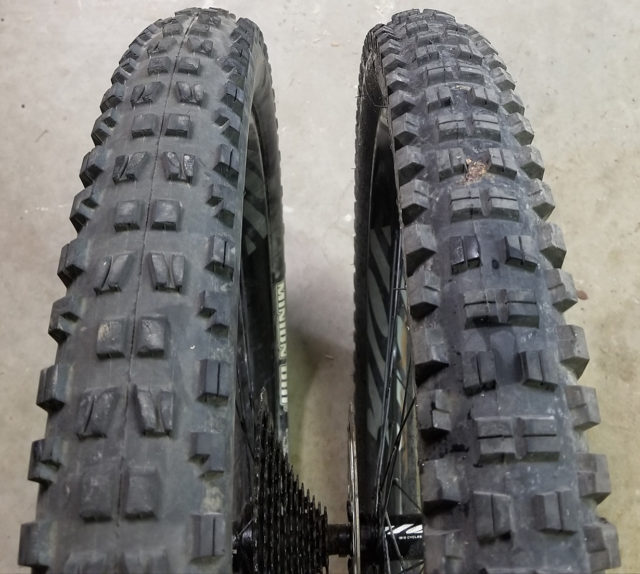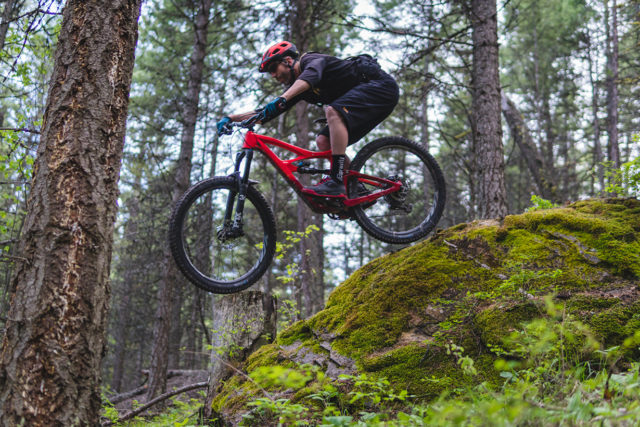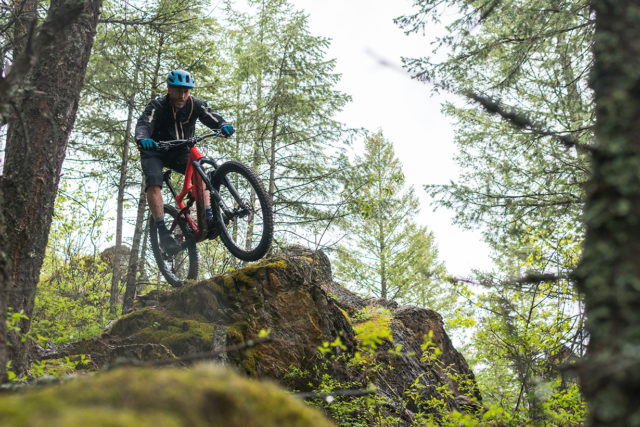
Terrene Chunk 2.6” Tire
Stated Width: 27.5” x 2.6”
Measured Dimensions (on a 35 mm internal-width rim):
- Knob width: 65 mm (2.56”)
- Casing width: 62.5 mm (2.46”)
Casing: Tough
Blister’s Measured Weight: 1143 g
Mounted to: Ibis Mojo HD4 / Ibis 742 wheels
Recommended For: Trail / All-Mountain
MSRP: $75 (as tested)
Reviewer: 5’9”, 155 lbs
Test Locations: Whitefish, MT
Days Tested: ~7
Intro
Terrene is still a relatively new player in the tire game, but they’ve recently been expanding their lineup and rounding out their options. Last year we looked at the Chunk in a 29 x 2.3” version and found it to be pretty good in a straight line, but that it struggled a bit in the corners and needed a pretty wide rim to achieve a proper profile.
Terrene has since expanded the Chunk lineup, and they’re now offering the Chunk in a 2.6” width, both for 27.5” and 29” wheels. And maybe more noteworthy is the fact that this wider width also sees a fairly significant revision to the tread pattern — the 2.3” Chunk remains the same, but the 2.6” Chunk is different enough that it could probably be called a completely different tire.
Sizes and Options
The Chunk is now available for 27.5” and 29” wheels in 2.3” and 2.6” widths, and it’s also available as a plus tire in a 27.5” x 3.0. The 2.3” and 3” have a generally similar tread pattern, but the 2.6” tread pattern is quite different.
In each size, the Chunk is available in both a “Light” casing and a “Tough” casing (which is what I rode). The Light iteration gets a single-ply, 120 tpi casing with an aramid bead, while the tough casing uses a 60 tpi fabric and incorporates “TekShield” flat protection, which appears to be an additional layer that runs bead to bead, but isn’t quite as heavy as a full second layer of fabric. Depending on the tire size, bumping up to the Tough casing adds around 100-200 g per tire.
All versions of the Chunk use Terrene’s dual-compound rubber, which has 62a center knobs, and softer 51a side knobs. Those rubber compounds put it pretty squarely in the “all-around” category, with a middle-of-the-road approach to balancing grip vs. rolling resistance and durability.
Every Chunk tire is designated as tubeless ready, and while I’ve read some reports of people struggling with tubeless setup on the Chunk, every Terrene tire I’ve mounted has gone on easily. On the Ibis 742 rims I was using, the 2.6” Chunk mounted up without issue, and I got the bead to seat without a problem, just using a regular floor pump. I’d say the Chunk’s tubeless setup was pretty standard compared to other good-quality tubeless tires.
The Tire Design
As I mentioned above, the 2.6” Chunk is a whole different beast than the 2.3” Chunk I’d reviewed previously. For starters, the tread has been completely redesigned — the 2.3” Chunk has a series of square-ish knobs that are relatively widely spaced and open. The 2.6” Chunk is vaguely reminiscent of a Maxxis DHR2 or Bontrager G5, with the center tread alternating between paddles and smaller, squarer knobs.
The 2.6” Chunk, like it’s narrower sibling, uses a non-directional tread; it’s symmetrical, and is the same in either direction. On the upside, that means you can flip the tire around when your braking edge starts to wear out. On the downside, it means there are no ramps to speak of, so the tire probably doesn’t roll as quickly as it would if it were directional.
The other noteworthy difference between the 2.3” Chunk and the 2.6” Chunk is that, while the 2.3” Chunk was a high-volume tire and looked fairly huge, the 2.6” Chunk is pretty reasonably sized, and actually looks slightly small by 2.6” standards.
As a comparison, a 2.6” Maxxis DHF (on the same rim as the 2.6” Chunk) measures slightly narrower at the maximum tread width (64 mm for the DHF, 65 mm for the Chunk), but the DHF measures a good bit wider through the casing (64 mm for the DHF, 62.5 mm for the Chunk). In other words, the DHF is a higher-volume tire than the 2.6” Chunk.
Below is a picture of the Maxxis DHF 2.6 (left) next to the Terrene Chunk 2.6 (right), both mounted to the 35 mm Ibis 742 rim. It can be tough to tell in these pictures, but the Chunk sits a bit rounder than the Maxxis, and the Chunk’s center knobs are a bit taller and blockier.

The Ride
I’ll give this caveat at the outset: I have generally not been sold on the 2.6” tire size. I’ve ridden an assortment of less-knobby, faster-rolling 2.6” options (like the Maxxis Rekon), and while they give a smooth ride, they don’t seem to offer much (any?) more traction than a narrower, knobbier tire, and the narrower tires tend to feel more precise and faster. And the 2.6” DHF was literally the first time I’ve ever ridden a DHF in any size or compound where I said to myself: “I really don’t like these tires.” They just felt sluggish everywhere, and as I mentioned in my review of the Ibis Mojo HD4, that bike felt a lot more lively as soon as I took off the 2.6” tires.
So mounting up the 2.6” Chunks, I can’t say I was exactly brimming with excitement.

But then I rode them. And I kinda liked them. I’m actually going to say that I liked them more than any other 2.6” tire I’ve ridden. And remember how a couple sentences ago I said that the Ibis Mojo felt a lot more lively once I took off the 2.6” DHF’s? Well, that bike felt great with some ~2.4” tires mounted up, and it still felt great when I swapped on the 2.6” Chunks.
So there are a couple factors that I think led me to like the Chunks more than the other options I’ve tried. First, the Chunk’s casing is narrower and it’s a slightly lower-volume tire. This makes the Chunk feel less squirmy, and it means when I’m running low-ish pressures (I experimented around a bit, but ended up running around 19 psi in the front, 21 psi in the back), the Chunk feels less inclined to fold over in corners. But the 2.6” Chunk is still a fairly wide tire, so you still get most of the smoothness that comes with running a bigger tire.
The second thing that I think helps out the Chunk is its slightly rounder profile, which means, in a straight line, there’s less tread on the ground. That rounded profile can be a double-edged sword — if it’s too round, it can be tough to lean the bike far enough to engage the side knobs, but I didn’t find that to be the case with the Chunk. It’s round enough to roll a little more efficiently, but not so round as to sacrifice cornering performance.

Finally, the Chunk’s rubber compound feels a bit harder than some of the tires from Maxxis. Normally, I’d prefer a softer compound that grips better, but in bigger tires like the 2.6” Chunk, those soft compounds start to feel sloooow. So in this context, I think the somewhat harder rubber that Terrene is using works out nicely, and as a side bonus, it takes a bit longer to wear out.
And what that all adds up to is a tire that feels a touch bigger than a normal 2.5” tire, but that still feels like it’s a ways off from getting into “Plus” tire territory. The big, unramped paddles offer up solid straight line traction, both while climbing and braking. And the side knobs are substantial enough to lock in nicely in corners, and I never got them to release unpredictably or do anything that was particularly unexpected.
Now, in fairness, a lot of the reasons I liked this tire have flip sides. If you care less about minimizing rolling resistance and more about maximizing grip, the Chunk perhaps falls short compared to, for example, that Maxxis DHF that I wasn’t a huge fan of. The Chunk feels less balloon-y, and the rubber doesn’t quite stick to roots and rocks the way something with softer rubber does.

Personally, I’d like to see the Chunk adopt a directional tread — I think it’d make it roll even faster, and I don’t think the climbing traction that it’d sacrifice would be problematic. And I’d tentatively like to see Terrene experiment with some fancier rubber compounds. The rubber in the Chunk is more or less similar to the dual-compound options that some companies like Maxxis offer, but triple- (or even quadruple!) compound tires can offer better traction without giving up too much ground in the rolling resistance department. But, of course, one of the reasons I liked this tire is because it rolled a bit quicker, so maybe a more exotic rubber mix would ruin that.
Durability
I didn’t get enough time on the 2.6” Chunk to really come to a well-informed conclusion on its durability, but I didn’t have any issues. I’ve spent a bunch of time on other tires with Terrene’s “Tough” casing and they’ve held up well. It’s not DH-tire levels of durability, but tires with the Tough casing are clearly burlier than any single-ply tire, or tires with just a minimal sidewall reinforcement (e.g. Maxxis Exo).
Bottom Line
There are a lot of people (and companies) jumping on the 2.6” bandwagon — that tire width offers up a bunch of traction and a smooth ride, and it’ll fit into most bikes and forks on the market. But those big tires have some downsides — they tend to roll slowly, weigh a bunch, and can feel squishy and imprecise when pushed hard.
Terrene’s Chunk 2.6” does a pretty damn good job of minimizing those downsides while still offering the main upsides of a 2.6” tire. While it’s pretty average in terms of weight for a reinforced tire of this width, the Chunk 2.6” rolls relatively quickly, has more cornering support than some other, higher-volume options, and it still sports meaty knobs that offer up the traction that you’d expect from a big tire like this. The biggest problem with this tire? The name. The 2.3” Chunk was a bit of a miss, but the 2.6” Chunk is a whole different tire, and it’s a pretty good one.
